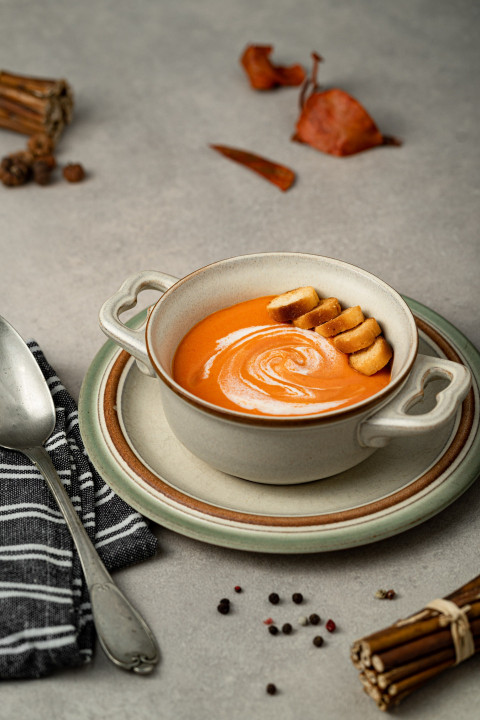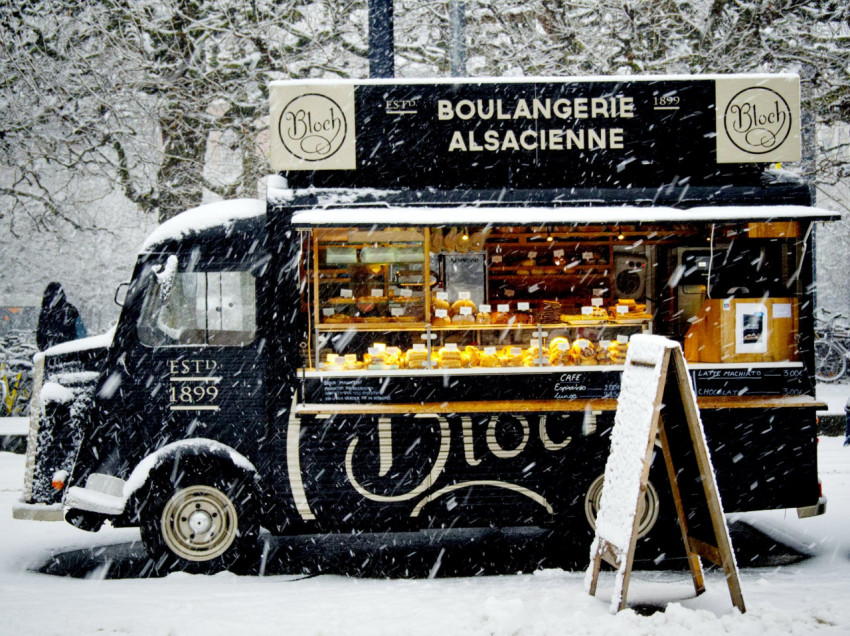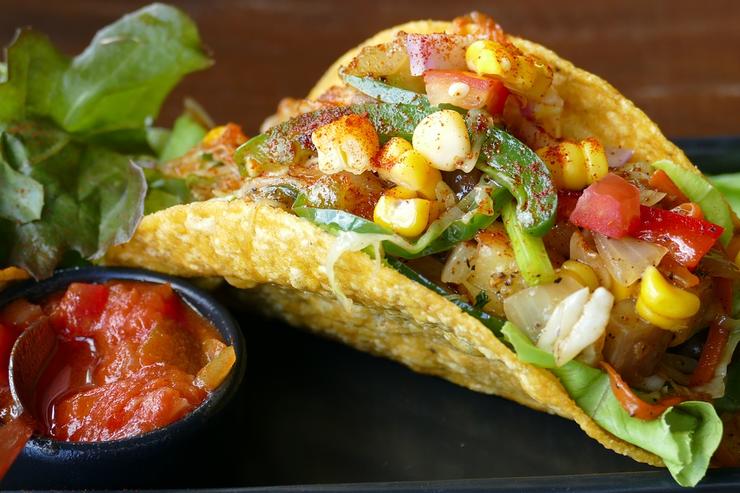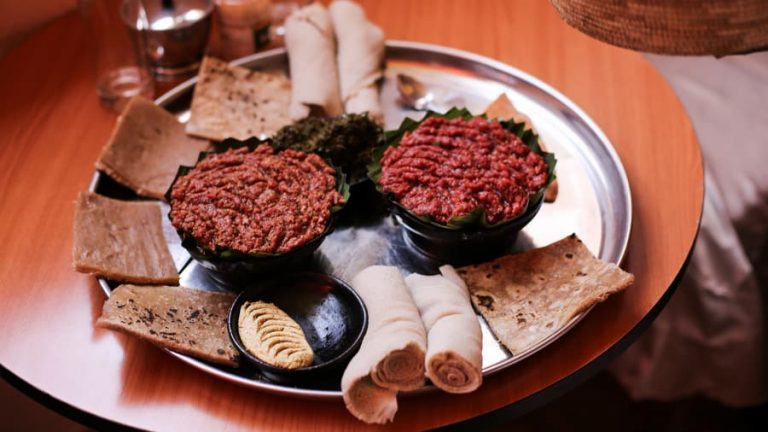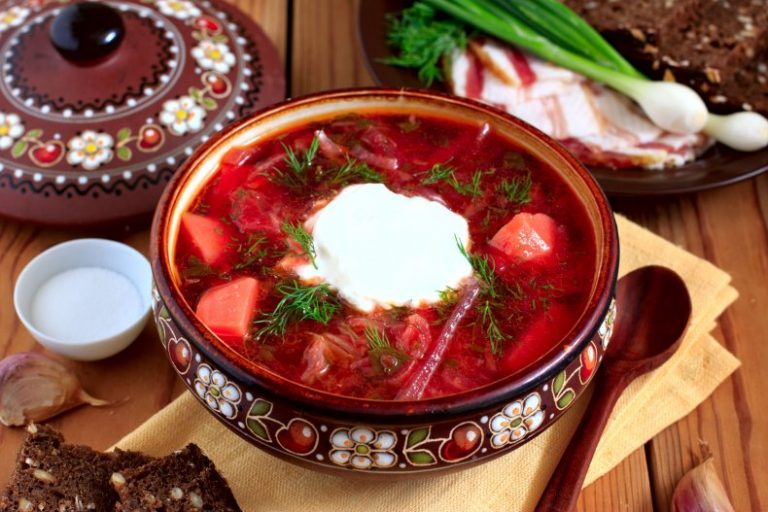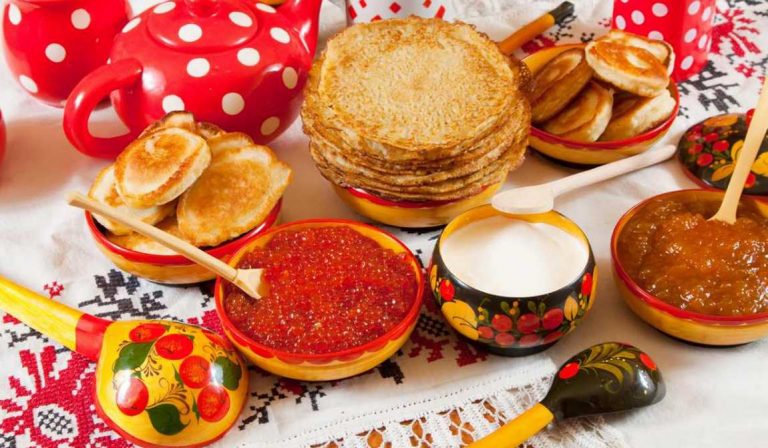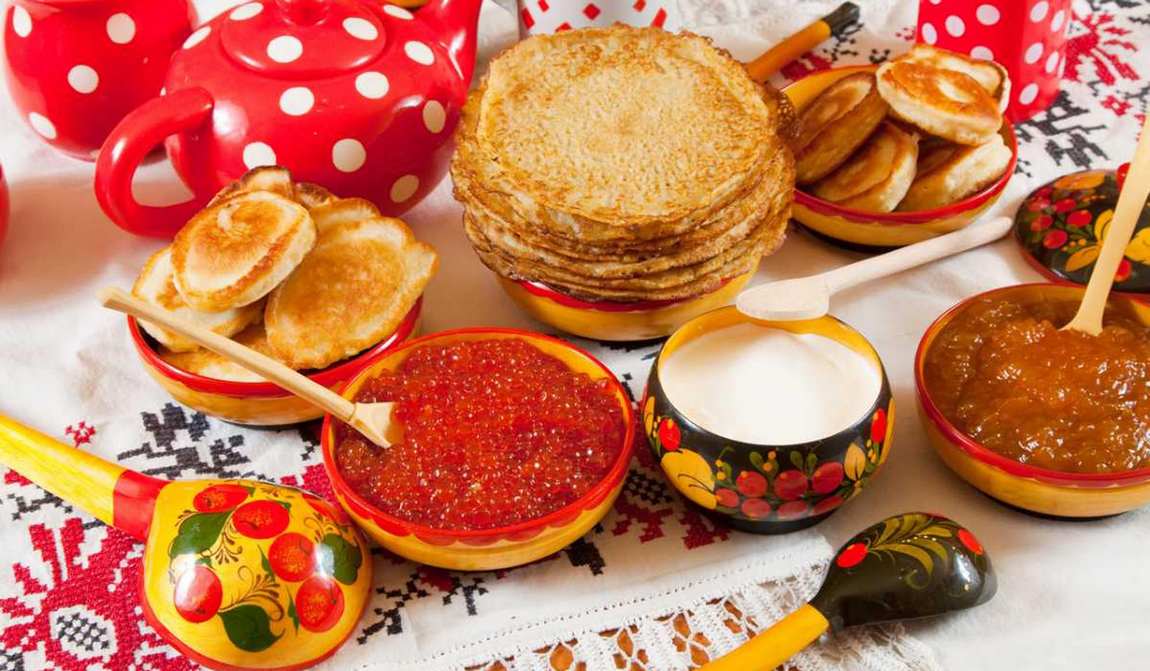The names of some Ukrainian dishes can mislead tourists who speak other Slavic languages. How not get confused about the menu and what to try from Ukrainian cuisine?
Features of Ukrainian Cuisine
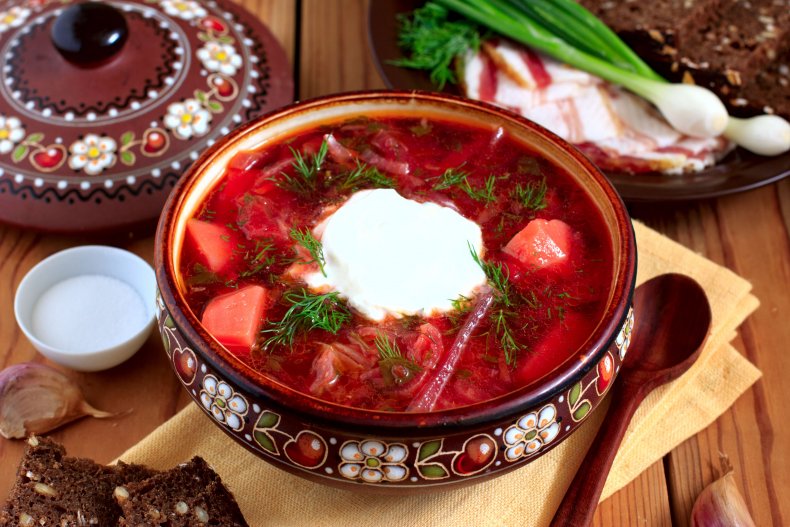
Ukrainian cuisine is delicious, hearty, and varied. It is even difficult to imagine that simple peasant dishes from their basis: they are prepared quickly and simply, and the result is excellent. The warm climate and fertile land played a role here. Thanks to this, cereals grow well in Ukraine, therefore, there are a lot of cereals and flour products in the national cuisine. In summer and autumn, a rich harvest of vegetables and legumes is harvested here – cabbage, beets, potatoes, carrots, zucchini, pumpkins, peas, beans. In addition, since the 19th century, Ukrainians have been growing sunflowers from which oil is made. They are fried in sunflower oil and seasoned with salads. Before the emergence of sunflower, rapeseed oil was used in Ukraine, and even more often – lard (melted pork fat). They are fried on lard even now, but this is more typical for home cooking.
Meanwhile, there are very few fried dishes in Ukrainian cuisine. Since everything was cooked in the oven, the products were boiled, stewed, or baked.
Meat – mainly pork and beef – was not eaten so often, so they tried to keep it smoked or dried for a long time. Garlic, horseradish, and herbs were used as aromatic additives: even now, when any spices are available, odorous, but not hot spices are chosen for Ukrainian dishes. Moreover, Ukrainian cuisine has absorbed the culinary traditions of neighboring countries. Therefore, in the Lviv region, they cook Polish flaks, in Bukovina – Moldavian hominy, in Transcarpathia – Hungarian goulash, and in the east of Ukraine – Russian okroshka. The dishes of Jewish cuisine have also taken root: for example, the Ukrainians have rethought the recipe for stuffed fish and add a little lard to the minced fish – it turns out juicy and tasty.
National Dishes of Ukraine
Salo is the main national food in Ukraine. Pork lard is salted, boiled, smoked, lard is melted from it, greaves are made, and ground with garlic. Today’s nutritionists disagree about this product, but it is known that lard contains valuable fatty acids, and there are relatively few unhealthy saturated fats. According to an anecdote, bacon causes sclerosis: ate a sandwich with bacon – and forgot about hunger for a long time.
Borsch – beet soup with meat broth. In Ukraine, red borscht is cooked in different ways: in some regions, beans are necessarily put in a saucepan, in others – prunes, in others – mushrooms, in fourths borscht is seasoned with flour, and in fifths – with smoked meats. Very often, a lek is added to the finished dish – crushed bacon with garlic, pepper, and herbs. It is customary to eat borscht with sour cream, and instead of bread, lean on donuts – soft buns, the crust of which is greased with vegetable oil and garlic.
Dumplings, or pies, are one of the most famous national dishes of Ukraine.
Dumplings are made stuffed with mashed potatoes, stewed cabbage, mushrooms, or meat, then before serving they are flavored with fried onions or cracklings – pieces of bacon fried to a crunch.
The filling can be sweet: from cottage cheese, cherries, blueberries, grated apples – sour cream is served with such dumplings. In addition, lazy dumplings are made: steep curd dough is cut into rhombuses or rolled into balls and boiled until tender.
Dumplings differ from other products made from unleavened dough with filling in shape: they look like a crescent. Often they pinch the edge in a special way as if braiding a pigtail.
Dumplings are pieces of unleavened dough boiled in water. They are eaten as a separate dish, seasoned with butter or sour cream, and sometimes added to a soup. Less often, dumplings are made with meat, cottage cheese, or berry filling.
Cheese is an important part of Ukrainian cuisine. You can’t make a banosh without fragrant cheese from goat or sheep milk, and vurdu – whey cheese – can be eaten just like that or used as a filling for dumplings. Two more dishes, although not related to the national cuisine, have long become the national food of Ukraine.
This is a Kyiv cutlet – a chicken fillet roll with a piece of butter inside rolled in breadcrumbs and deep-fried, as well as “Kyiv cake” – two layers of nut meringue fastened with buttercream.
Chicken Kyiv is prepared in many restaurants, and it is easier to buy a cake in a supermarket or pastry shop.
Snacks

Snacks in traditional Ukrainian cuisine are mostly festive dishes. Cooking many meats was a way to preserve the product for a long time, and vegetable snacks, especially pickles, diversified the meal in winter or spring.
Saltison, or salceson, kovbik, kendyukh – boiled pork offal with garlic and spices, which are stuffed into the pork stomach and baked.
Gurka is a homemade sausage made from pork blood or offal. Rice, millet, or corn grits are also added to the minced meat.
Polyadvitsa – dried pork or beef tenderloin. This dish is traditionally prepared for Christmas.
Matsik is another type of jerky pork. The meat for it is coarsely cut, mixed with salt and spices, and then tightly placed in the pork stomach and dried for several months.
Wujenina – smoked meat.
Kryzhavki – cabbage pickled in vinegar. Usually it is pickled with beets, so the cabbage turns pink.
Mezhivo is a vegetable stew that can be prepared from zucchini, carrots, pumpkin, eggplant, and tomatoes. Cold mezhivo serves as an appetizer, hot – an independent dish or side dish.
Machanka is a cross between a thick soup and a sauce in which you can dip bread or pancakes. Machanka is made from finely chopped meat and onions, the broth is thickened with flour. Instead of meat, mushrooms are used, adding sour cream to the sauce.
Jellied meat, or dragal, is a cold snack made from boiled meat in a frozen concentrated broth. In Ukraine, pork jellied meat is often cooked, less often from beef or poultry. Serve it with horseradish or mustard.
Salads
The recipes for Ukrainian salads are ingenious but reasonable: everything that grows in the garden is used. And in the spring, when there are no fresh vegetables and stocks are running out, salads are made from boiled eggs, potatoes, and the first greens – for example, from wild garlic.
Mіzerіya is a salad of fresh cucumbers and herbs with sour cream, which is prepared in Western Ukraine and Poland.
Varya hutsulska is a healthy salad of boiled beets, beans and prunes, seasoned with vegetable oil.
Soups
In addition to borscht, other soups are brewed in Ukraine, as a rule, in meat broth. During Orthodox fasts, meatless soups are prepared.
Kapusnyak is a rich soup with fresh or sauerkraut. For density, it is seasoned with millet, mashed boiled potatoes, and sometimes flour.
Zeleniy borscht – soup with sorrel or other herbs (nettle, quinoa). Often, green borscht is boiled with the addition of beets.
Bograch – Transcarpathian interpretation of Hungarian goulash, thick beef soup.
Yushka – meat, fish, or mushroom broth, as well as liquid soup seasoned with vegetables or cereals. Yushka z lek is a soup with crushed bacon dressing.
Mushroom (mushroom) zupa, or mushroom yushka, is a popular porcini mushroom soup in the Carpathians.
Cold borscht – summer soup with beet broth, infusion, or kvass. Fresh cucumbers, boiled potatoes, hard-boiled eggs, finely chopped meat are poured with chilled broth.
Already at the table, the soup is seasoned with horseradish and sour cream, sprinkled with herbs, and sometimes finely chopped beet tops.
Yarinova zupa – vegetable soup.
For the soup, you can be offered knishi – round buns with unsweetened filling, or potaptsi – brown bread croutons.
Some common soups may be hidden behind unusual names. For example, in the Lviv region, the broth is called rosil, and green sorrel borscht is called kvask soup.
Meat Dishes
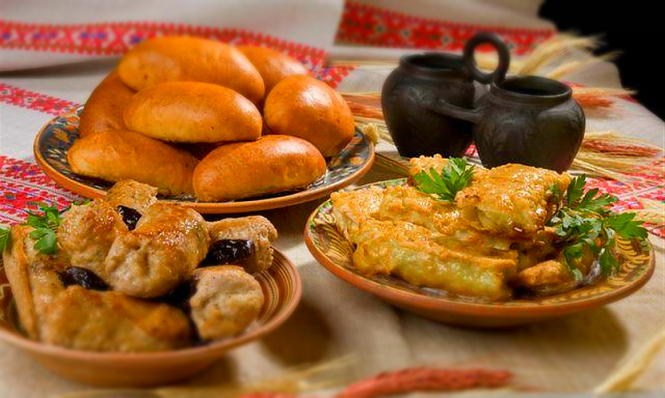
Unlike Russian cuisine, where meat is used little, Ukrainian cuisine has many recipes for meat dishes. The liver is a stew of meat with potatoes, beans, carrots, and onions. Sometimes cookies are cooked without potatoes, but then the popular tuber is served as a side dish. Chinakhi, or chanakhi, is a cookie-like dish common in Bukovina. Smazhenina – fried meat, usually pork, but in modern recipes and beef, lamb, chicken. Potatoes are sometimes fried along with meat. Sicheniki – cutlets from minced meat or fish. Grechaniki – cutlets, which include equally beef / minced pork and boiled buckwheat. Golubtsі – meat filling, wrapped in cabbage leaves. There are different recipes for stuffed cabbage: only minced meat, or meat with rice, or even thinly beaten pieces of meat can be wrapped in cabbage. Cabbage rolls are stewed with the addition of tomato paste and sour cream. Fried meat – fried meat, often ribs, with large beans, which is cooked in the western regions of Ukraine. Baked sponder – brisket (brisket) cooked in the oven or bacon, fatty meat with a lot of lard. The sponder is rubbed with salt, pepper, and herbs before baking. Platbands are thin pancakes in which different fillings are wrapped: minced meat from boiled meat or fish, stewed mushrooms, sweet cottage cheese, berries and fruits, jam. Krucheniki – delicious meat rolls. For their preparation, pork or beef tenderloin is cut into layers, beaten off and a filling is wrapped in each layer: mushroom minced meat, chopped egg with onions, rice, dried fruits. The finished rolls are fried and then stewed until tender.
Vegetables and Cereals
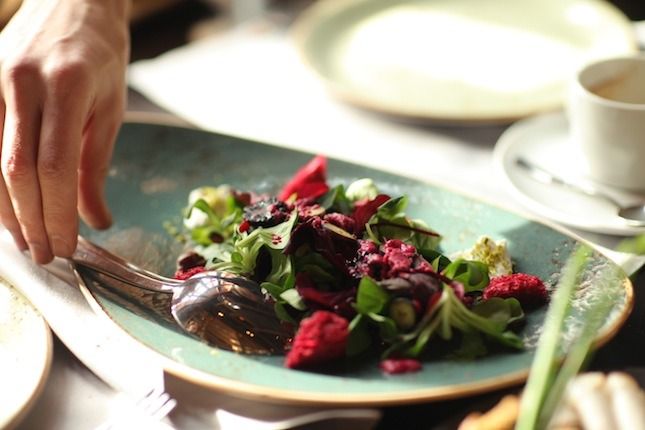
There are a lot of vegetable dishes in Ukraine. Vegetables, as a rule, are stewed or baked, but potatoes are fried, and boiled, and stewed, and baked, used to make the dough and as a filling. Deruni, or grated potatoes, kremzliki – grated potato pancakes. In the simplest version, potato pancakes are fried until golden brown and served with sour cream. In more complex recipes, potato pancakes are stuffed with minced meat, fried, and then baked in pots with mushrooms and sour cream. Kartoplyaniki, or lezhnі – zrazy from potato dough with meat, mushroom, or cabbage filling. Sticks, or sticks, are small oblong products made from potato dough. The sticks are boiled like dumplings or dumplings and poured with hot lard and fried onions. Cabbage is boiled – stewed cabbage baked with millet porridge. Often this dish is complemented with cracklings. Porridge has a place of honor in the national cuisine of Ukraine. But if buckwheat, wheat, or barley porridge is well known to everyone, then some cereal dishes can be tasted only in Ukraine.
Banosh, or banush, is a popular dish of the Ukrainian Carpathians, which is prepared from corn flour or cereals. During cooking, cream or sour cream is added to the porridge, and the finished banosh is sprinkled with cracklings and crumbled feta cheese. Kulesha and tokan dishes are similar to banosh.
Mamaliga is a steeply cooked corn porridge. Mamalyga can be crumbled and poured with hot milk, or it can be cut into layers, fried, and sprinkled with grated feta cheese. Mamalyga also serves as a classic side dish for fryptour – juicy stew (Bukovina also borrowed this recipe from Moldovan cuisine). And also hominy cakes can be used instead of bread. Kulish – millet porridge with bacon and fried onions. This porridge was cooked by Zaporozhye Cossacks, and now it is an integral part of Ukrainian cuisine. To make the porridge more satisfying, potatoes, carrots, mushrooms, and less often meat are added to it. Kutya is a special porridge made from whole wheat grains with poppy seeds, raisins, and nuts, which is prepared for Christmas. Buckwheat flour, like wheat and rye, was used to make lasanki – a type of pasta. Lasankas are given different shapes, sometimes they are just sheets of dough boiled in water.
Fish
The rivers of Ukraine are rich in fish, and therefore fish dishes are not uncommon in Ukrainian cuisine. Here you can taste something simple, like fried crucian carp, or complex dishes – stuffed pike, pike perch, or bream in sour cream sauce. Trout, or pstrug, is found in the Carpathian rivers. This valuable fish is boiled, fried, baked.
The Black Sea herring enters the waters of the Danube; in the Odessa region, it is called so – Danube. The Danube is salted like a common herring, or boiled with potatoes, seasoning the water for cooking with pepper and bay leaves.
And in Ukraine, crayfish are excellent cooked. They are boiled with herbs and roots and then served with garlic oil or sour cream sauce.
Desserts
Among the traditional dishes in Ukraine, there are many sweet pastries. Especially a lot of sweets are baked at Christmas and Easter. Pirіzhki – products made from yeast dough with a filling, not necessarily sweet. For the dessert table, they make pies with poppy seeds, rhubarb, cherries, blueberries, viburnum, apples, cottage cheese. The most unusual of the sweet fillings are beans with raisins. Perekreklyenets is a yeast dough pie in which poppy, fruit, berry, or nut filling is laid out in several layers, interspersed with the dough. Different fillings are often put in one pie. Plyatski is a popular name for pies in Western Ukraine, in which the cakes are sandwiched with cream and other fillings. Plyatski are baked in rectangular forms, and served on the table cut into individual cakes. If the menu includes a dance with a lucer, you can safely order it for your child: a lucer is just a fudge. Sirnik is a delicious Western Ukrainian curd dough pie. The taste of cheesecake is decorated with berries, candied fruits, raisins, chocolate, nuts. And the most airy pies are obtained when mashed potatoes are added to the curd. Verguni, or pletuni, are crispy cookies made from thinly rolled yeast dough, which are fried on lard and sprinkled with powdered sugar before serving. Pundikas are donuts fried in vegetable oil or lard. Now they are made sweet, and earlier donuts were flavored with fried onions. Птисі – eclairs. Zavivanets – a roll of yeast dough with sweet filling: poppy, nut, berry.
Drinks

What is cooked in the berry season, when the dumplings are stuck and the pies are baked? Of course, compotes and jelly. A cool sour drink made from red currants or cherries is what you need on a hot summer day. Butter is a product obtained by whipping butter from cream. The low-fat drink is rich in protein and is an excellent thirst quencher. Sour milk, sour milk, samokish – yogurt, which is obtained by fermentation with the help of lactic acid bacteria present in milk. Guslyanka is a thick drink made from fermented boiled milk, traditional for Carpathian cuisine. It can be called a drink conditionally, since the gargle is best eaten with a spoon. Varenets is a drink made from fermented baked milk. Tsibrey – kvass made from rye or oat flour, which is still prepared in the Carpathians. Uzvar – infusion or compote from dried apples, pears, plums. Traditionally, uzvar is made at Christmas, but it is also drunk in summer as a soft drink, and in winter it serves as a source of vitamins.
Of course, it is worth trying the healing mineral waters that are mined in Ukraine: “Truskavetska”, “Morshynska”, “Shayansku”. You can drink them constantly only as prescribed by a doctor, but if you buy them sometimes to quench your thirst, it will not hurt anyone. The most valuable water “Naftusya” is not bottled: it quickly loses its healing properties, and it is necessary to drink it right at the pump room in the resort of Truskavets.
Tips for Kids
When traveling around Ukraine with children, you don’t have to puzzle over how to provide baby food. Almost all the national food of Ukrainians is suitable for children and does not require adaptation. The list of dishes that should not be offered to a child is very short: smoked and jerky meat (wujenina, poladvitsya, matsik), pickled vegetables (kryzhavki), very fatty dishes (pork jellied meat, grease). We do not recommend ordering food with cracklings for younger children.
It is very easy to feed babies who are switching to adult food. In all restaurants, you can order light broth, vegetable soup, porridge, boiled potatoes, stewed vegetables.
Of course, not all Ukrainian dishes meet the principles of modern dietetics. But if you eat dumplings with potatoes or stewed potatoes with meat once or twice, you can hardly harm your health. And there are much more healthy dishes in the national cuisine. So that there are no problems with new food, offer your child fermented milk products every day – sour milk, guslian, varenets. You can buy the usual yogurt and kefir in supermarkets.






